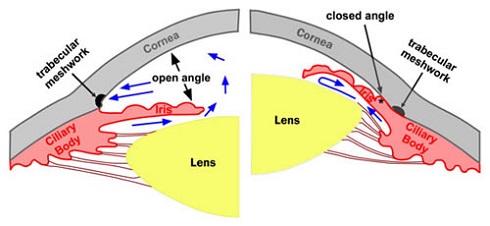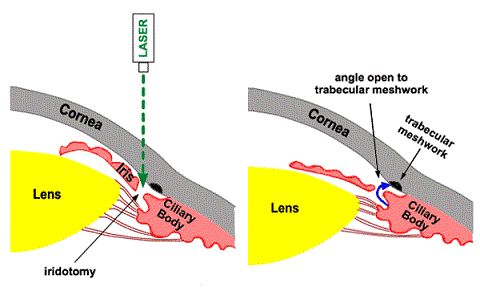Why is laser iridotomy necessary?
Laser iridotomy, also known as laser peripheral iridotomy or laser PI, is performed to widen the drainage angles for patients with narrow angles or angle closure glaucoma. The laser reduces the risk of developing high eye pressure due to a closed angle, which in turn reduces the risk of further optic nerve damage from glaucoma.
Fluid in the eye (aqueous) is produced by the ciliary body, and drains out through the trabecular meshwork (drainage pathway) in the drainage angle. When the angle is narrow or closed off by the iris (the colored part of the eye), aqueous drainage is obstructed, causing pressure to build up in the eye. When the pressure in the eye is too high, it causes damage to the optic nerve and permanent vision loss – this is called glaucoma.

If laser iridotomy does not work (around 25% do not succeed) a different type of laser (laser iridoplasty) or cataract surgery (lens extraction) may be required to widen the drainage angle effectively.
See Related: Is my glaucoma ‘open angle’ or ‘closed angle’?

Sometimes, the opening may close up over time. If this occurs, the laser will need to be repeated.
Please note that laser iridotomy is not laser vision correction and therefore does not improve your vision.
See Related: Laser treatments for glaucoma
What are the potential risks?
Laser iridotomy is a very safe procedure. Complications are usually mild and generally do not result in any permanent damage. These include:
● Scratch on the front window of the eye (cornea)
● Inflammation in the eye
● Bleeding in the eye
● High pressure in the eye
● Discomfort in the eye. Rarely, this persists and can be bothersome.
● Streak or flash of light, most noticeable in the dark.

Normally, light only enters the eye through the pupil. After laser iridotomy, the additional opening in the iris may also allow light to enter the eye. This may be seen as glare or a streak or flash of light, and generally settles without treatment. In rare occasions, this remains persistent and may become bothersome.
What should I expect?
Laser iridotomy is an office-based procedure, and does not require sedation or admission to the hospital. Both eyes will usually require treatment, but not on the same day.
Before laser:
On the day of your procedure, please take all your usual medications unless otherwise advised. You will not be able to drive home on the day of the procedure, so you will need to arrange for someone to take you home. Please allow at least 2 hours.
Before the laser procedure, 3 types of eye drops will be put in your eye undergoing laser:
● Pilocarpine to constrict the pupil. This can take up to 30 minutes to work.
● Brimonidine to reduce the risk of eye pressure spikes following laser
● Local anesthetic to numb the eye
Please note that pilocarpine blurs the vision and can cause a headache. This can last a few hours.
During laser:
The laser is performed with the patient seated at the laser machine. The laser is delivered through a special contact lens that is placed on the eye. You will feel some discomfort with the initial laser shot, but this decreases with subsequent laser shots. The laser itself takes only a few minutes to perform.
After laser:
After the laser, your eye pressure will be rechecked between 45 to 60 minutes later to make sure it is not high. You will need to continue your usual glaucoma eye drops (if any) after laser treatment. In addition, you will be given a steroid anti-inflammatory eye drop (usually Dexamethasone) to use 3 times daily for 1 week. If your eye pressure is high after laser, you may be given additional pressure lowering medications, either as eye drops or tablets.
Over the next few days, you may experience some blurriness, irritation, and sensitivity to light. This will gradually improve without any treatment.
Recovery can sometimes take a few days, but you can go back to work the next day if you wish.
You will usually be reviewed 2 to 4 weeks after laser.
See Related:


